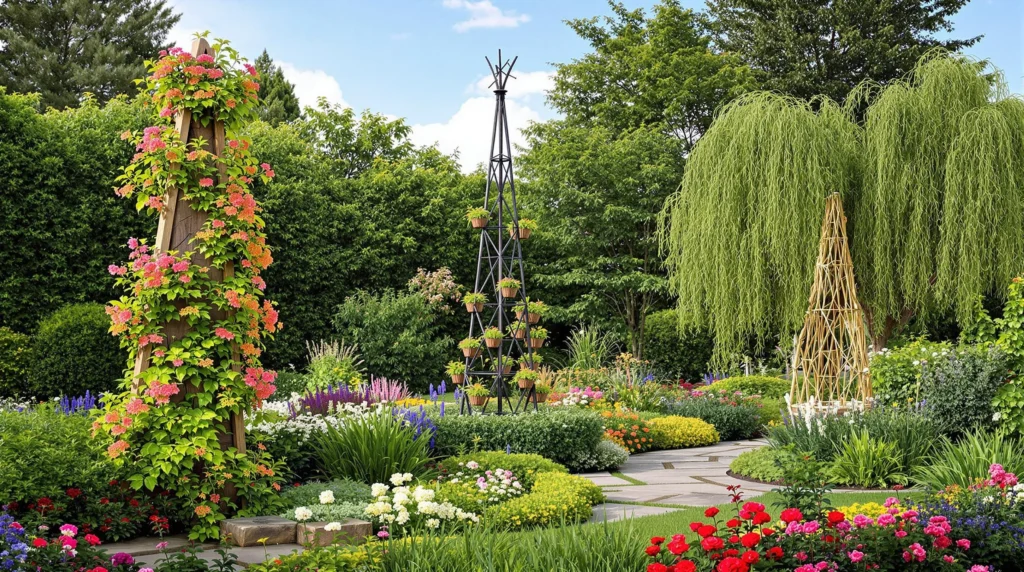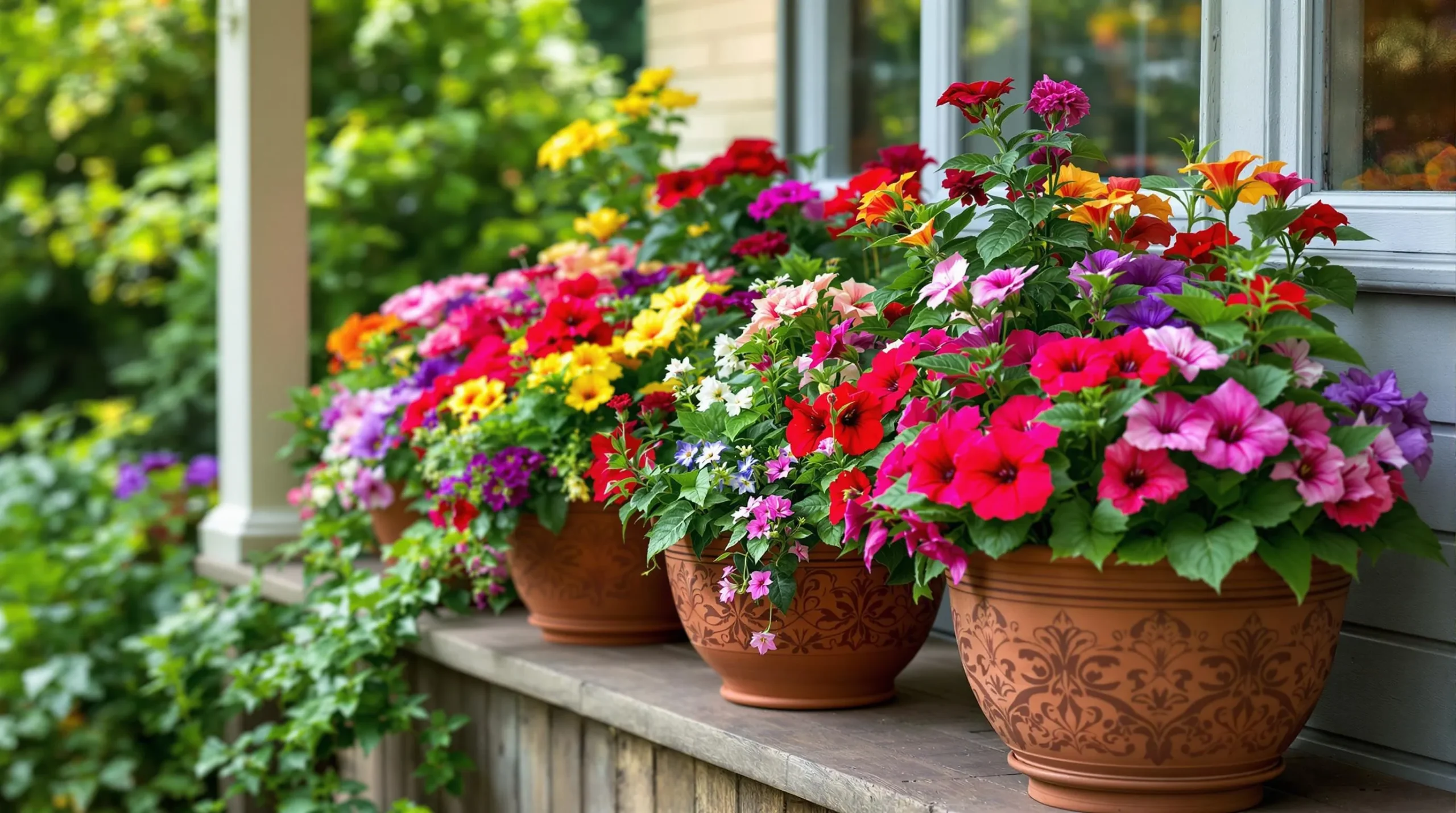10 Stunning Garden Obelisk Ideas to Transform Your Outdoor Space
1. Copper Pipe Obelisk
Create a modern, eye-catching focal point with a copper pipe obelisk. This sleek design develops a beautiful patina over time, adding character to your garden beds. Copper’s natural antimicrobial properties also help deter certain plant diseases while supporting climbing roses or clematis.
2. Repurposed Ladder Obelisk
Transform an old wooden ladder into a rustic obelisk by positioning it vertically and securing it with stakes. You’ll give new life to a discarded item while creating a charming support for morning glories or runner beans. Sand and seal the wood to extend its outdoor lifespan.
3. Willow Branch Obelisk
Create a natural-looking obelisk using flexible willow branches woven together in a conical shape. This biodegradable option blends seamlessly into cottage gardens and provides excellent support for sweet peas and lightweight climbers. Harvest branches during winter for best flexibility.
4. Wrought Iron Scroll Obelisk
Invest in a decorative wrought iron obelisk featuring ornate scrollwork for timeless elegance. These durable structures create dramatic vertical interest even when plants are dormant and can support heavier climbers like wisteria or grape vines without bending.
5. LED-Illuminated Obelisk
Install an obelisk with integrated solar-powered LED lights to add magical nighttime dimension to your garden. The soft illumination highlights climbing plants after dark and creates a stunning focal point for evening entertainment spaces. Position in full sun for optimal charging.
6. Reclaimed Window Frame Obelisk
Connect four old window frames into a pyramidal shape for a unique architectural obelisk. This conversation-starting piece adds vintage charm while allowing delicate vines like jasmine to weave through the openings. Remove any loose paint and treat wood with preservative.
7. Bamboo Teepee Obelisk
Construct a sustainable, lightweight obelisk by arranging bamboo poles in a teepee formation. This eco-friendly option works perfectly for vegetable gardens supporting pole beans or peas. Bind the poles together with natural jute twine for an organic aesthetic.
8. Concrete Reinforcement Mesh Obelisk
Form industrial reinforcement mesh into a cylindrical obelisk for an urban garden statement. The galvanized material weathers beautifully and provides exceptional support for vigorous climbers like honeysuckle. Bend the wire base outward for added stability.
9. Driftwood Stack Obelisk
Assemble bleached driftwood pieces in decreasing sizes to create a coastal-inspired obelisk. This natural sculpture doubles as plant support and brings seaside charm to any garden space. Drill and connect pieces with rust-resistant rods for stability.
10. Geometric Metal Obelisk
Choose a contemporary geometric obelisk featuring clean lines and angular patterns. These architectural pieces make bold statements in minimalist garden designs and provide striking structure during winter months. Look for powder-coated options to prevent rust and maintain appearance.
Creating a DIY Wooden Garden Obelisk for Climbing Plants
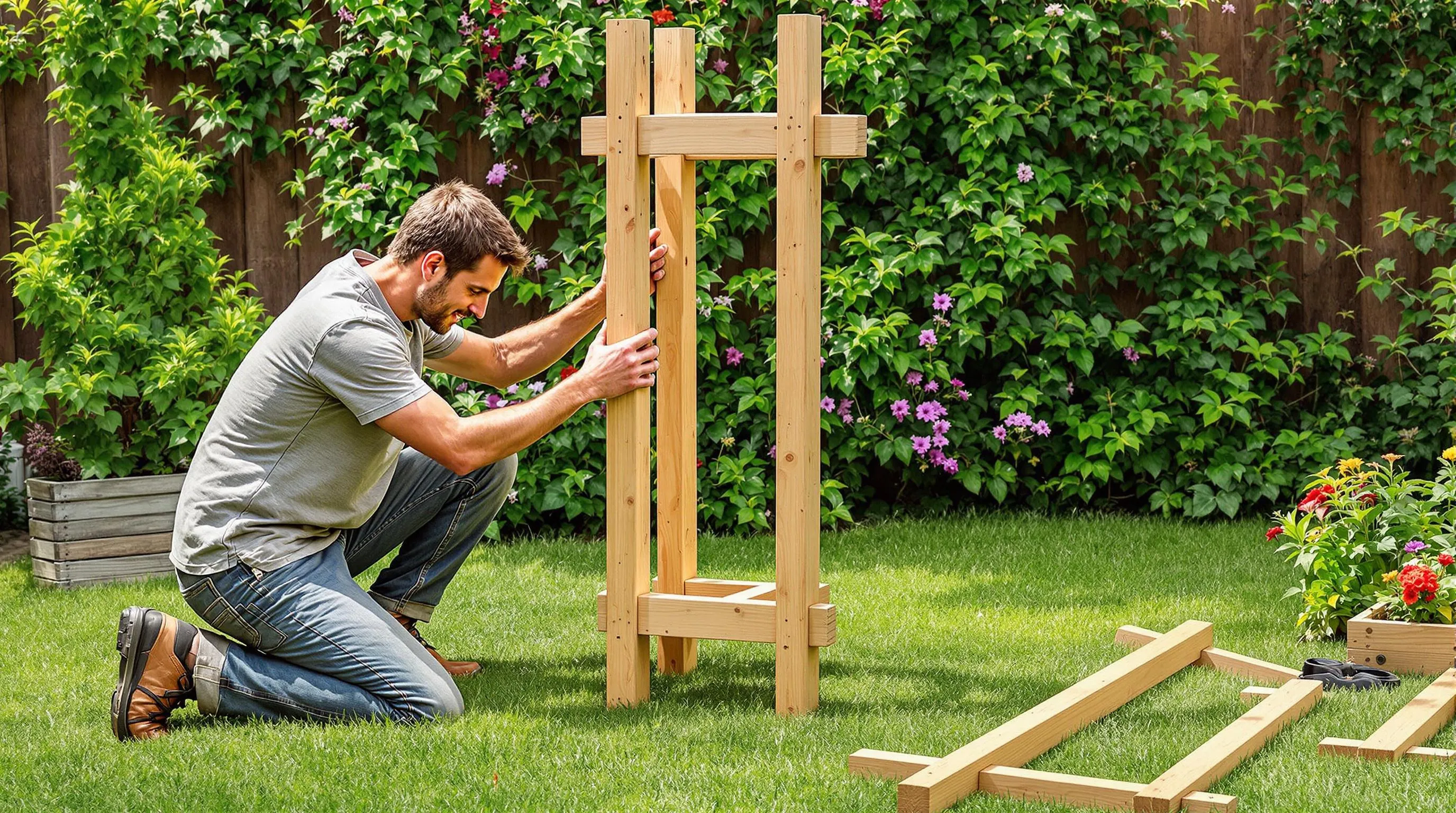
Building your own wooden garden obelisk is a rewarding project that can save you money while adding a personalized touch to your garden. This elegant structure provides perfect support for climbing plants like clematis, jasmine, or morning glories while serving as a striking focal point in your industry.
Selecting the Right Wood for Your Obelisk
Choose cedar, redwood, or pressure-treated pine for your DIY garden obelisk to ensure durability and weather resistance. Cedar and redwood naturally resist rot and insects, making them ideal choices even though their higher cost. Pressure-treated pine offers a budget-friendly alternative that still provides good longevity. Avoid untreated softwoods like standard pine or fir as they’ll quickly deteriorate in outdoor conditions. When selecting lumber, look for straight boards without warping, cracks, or knots, and opt for 1×2″ or 2×2″ pieces for the vertical supports and crosspieces. For a more rustic appearance, consider using branches from your garden that measure 1-2″ in diameter.
Step-by-Step Building Instructions
Start by cutting four 6-8 foot lengths of your chosen wood for the vertical supports and twelve 12-18″ pieces for the horizontal crosspieces. Lay out two of the vertical pieces parallel to each other about 12″ apart. Attach three crosspieces horizontally between them using weather-resistant screws or galvanized nails at equal intervals, creating a ladder-like panel. Repeat with the remaining two vertical pieces to create a second identical panel. Connect these two panels at right angles to form a square base, then gradually bring the tops together and secure them to create a pyramid shape. Add the remaining crosspieces to the open sides for stability and visual appeal. Sand any rough edges, and apply an outdoor wood sealer or paint to protect your obelisk from the elements. Position your completed obelisk over your climbing plants, ensuring it’s firmly anchored in the soil or attached to a sturdy base to prevent tipping.
Wrought Iron Garden Obelisks for Vintage Charm
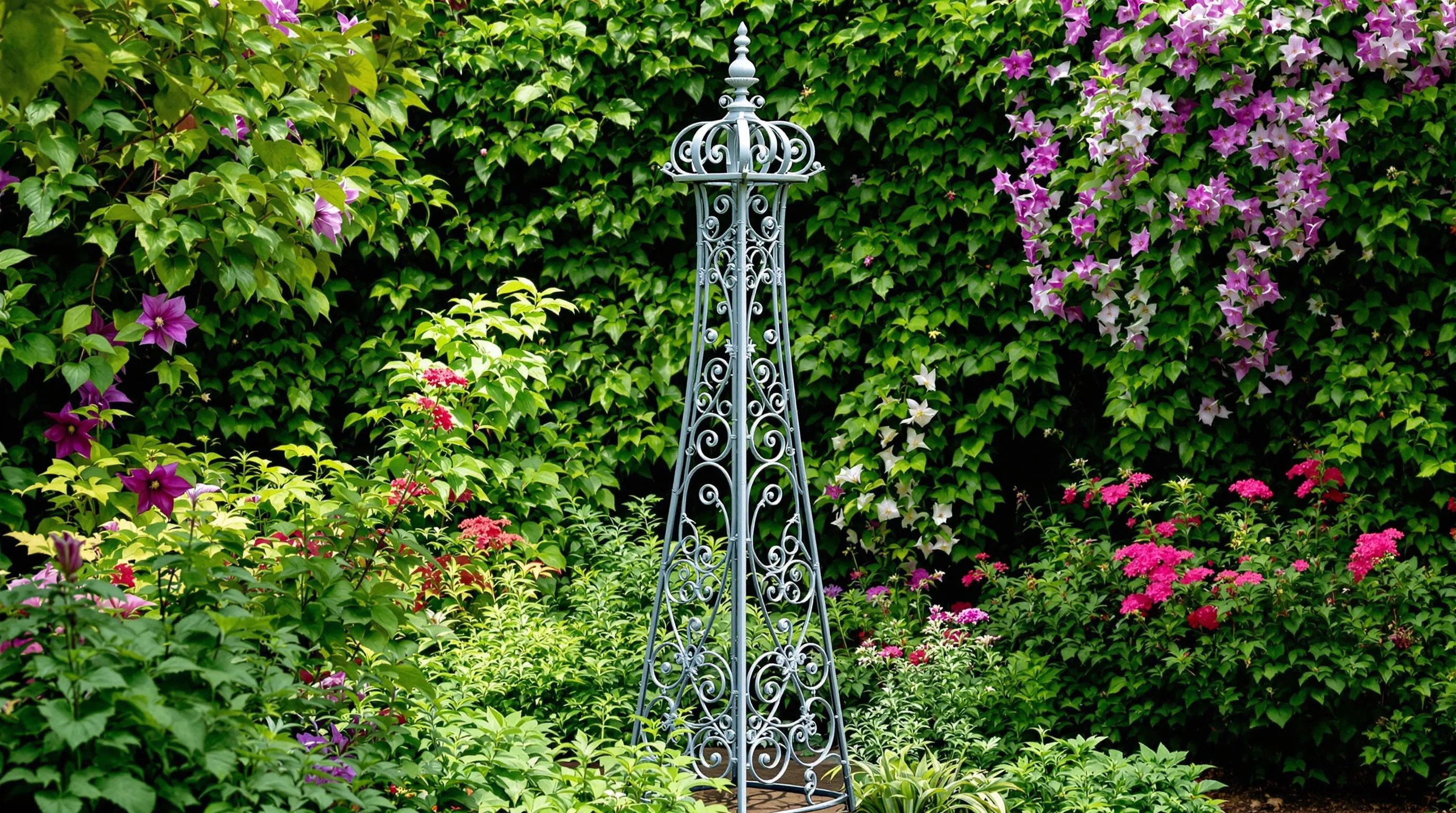
Wrought iron garden obelisks bring timeless elegance and Victorian-era character to any outdoor space. These sturdy metal structures feature ornate scrollwork, decorative finials, and intricate patterns that instantly add sophistication while providing robust support for climbing plants. You’ll find these classic pieces create striking focal points in formal gardens, cottage-style landscapes, or even contemporary settings where a touch of vintage charm is desired. Their dark silhouettes stand out beautifully against green foliage, creating dramatic visual interest throughout the seasons.
Placement Tips for Iron Obelisks
Position your wrought iron obelisks where they’ll create maximum visual impact—try placing them at the end of garden pathways, in the center of circular beds, or as sentinels flanking entrances. These versatile structures work particularly well in rose gardens, herb spirals, or mixed perennial borders where climbing plants can intertwine with the metalwork. For smaller gardens, use a single statement obelisk as a focal point, while larger landscapes benefit from groupings of varying heights. Consider the sun patterns in your garden, as climbing plants like clematis and jasmine require adequate sunlight to thrive on their iron support. During winter months, your wrought iron obelisks will continue adding architectural interest even without foliage, creating striking silhouettes against snow or winter skies.
Maintenance and Care for Metal Garden Features
Protect your wrought iron obelisks from rust and deterioration with regular maintenance throughout the seasons. Apply a protective coat of outdoor metal paint or sealant annually, paying special attention to any scratches or chips that might expose the raw metal. Before winter arrives, remove plant debris and check for loose connections or developing rust spots. For stubborn rust patches, gently scrub with a wire brush before applying rust converter and fresh paint. During growing seasons, periodically trim back excessively heavy vine growth that might strain the structure, and avoid allowing climbing plants to completely engulf decorative elements. Store portable obelisks in a protected area during harsh winters if possible, or consider anchoring larger pieces securely to prevent damage from strong winds. With proper care, your wrought iron garden obelisks will maintain their vintage charm for decades, becoming cherished garden heirlooms.
Copper Pipe Obelisks: Modern Garden Statements
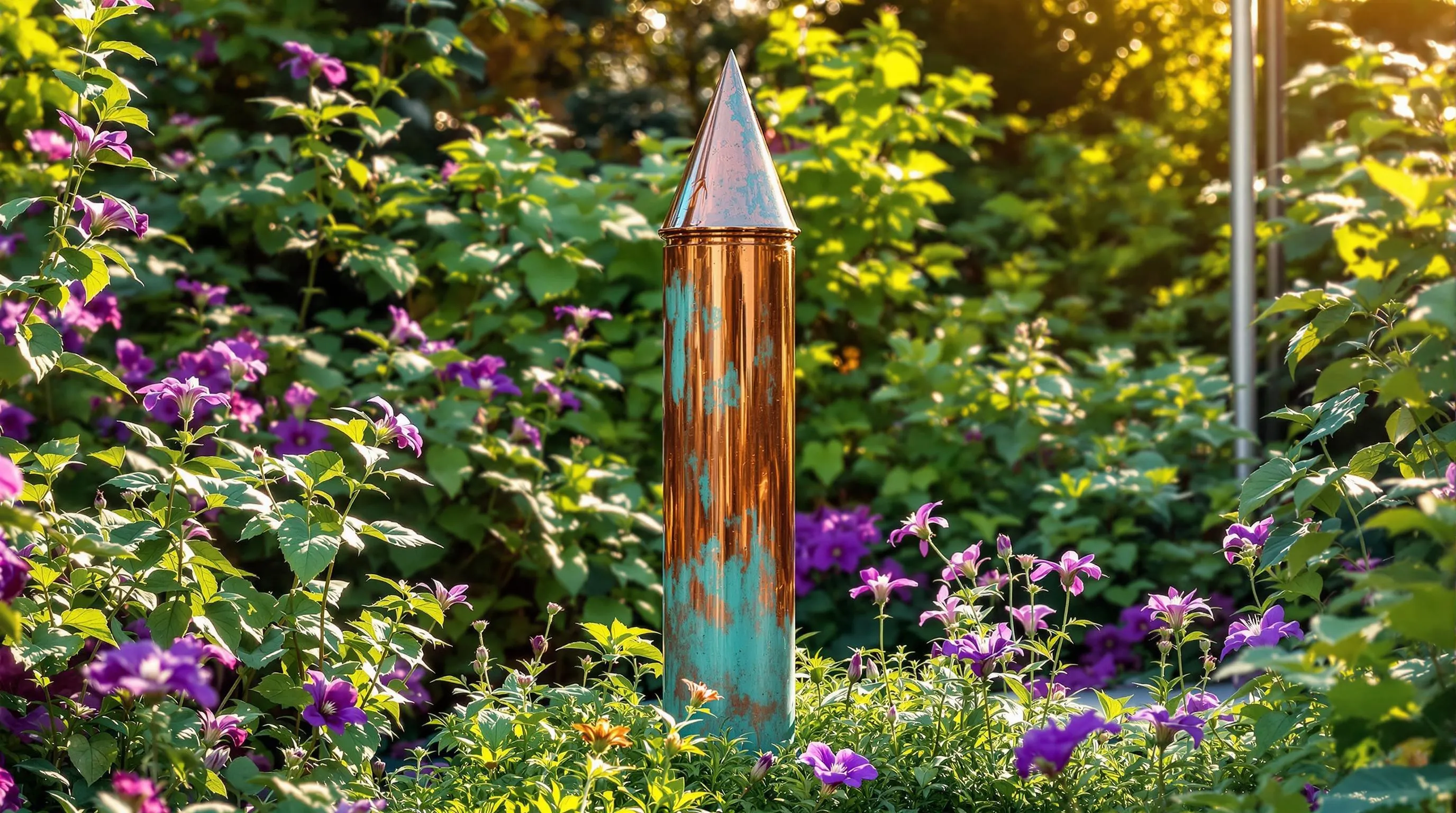
Copper pipe obelisks bring a touch of contemporary elegance to any garden space. These striking structures offer the perfect blend of industrial chic and natural beauty, making them increasingly popular among modern gardeners seeking a distinctive focal point.
Patina Development on Copper Garden Elements
Copper’s living finish is perhaps its most captivating feature in garden applications. When new, copper obelisks showcase a bright, salmon-pink metallic sheen that stands out dramatically against green foliage. Over time, exposure to the elements triggers a natural oxidation process, transforming the copper through a series of color shifts. Within months, the surface develops warm brown tones before gradually transitioning to turquoise-green verdigris patina after several years. This natural aging process creates a unique character that enhances rather than diminishes the obelisk’s beauty. For gardens with historical or cottage themes, you can accelerate patina development by applying commercial patina answers or a homemade mixture of salt, ammonia, and vinegar to achieve an aged appearance more quickly.
Design Ideas for Contemporary Gardens
Copper pipe obelisks offer exceptional versatility for modern industry designs. Create minimalist structures using straight copper pipes arranged in clean geometric patterns for zen or contemporary gardens. For added visual interest, incorporate gentle curves or spiral elements that catch light throughout the day. Mixing copper with contrasting materials like dark steel or concrete bases establishes a compelling industrial aesthetic. These structures particularly complement purple-flowered clematis, orange nasturtiums, or blue morning glories, as these colors create striking contrasts against the copper background. Position copper obelisks where they’ll catch morning or evening sunlight to maximize their warm metallic glow and make them functional art pieces rather than mere plant supports.
Repurposed Materials for Eco-Friendly Garden Obelisks
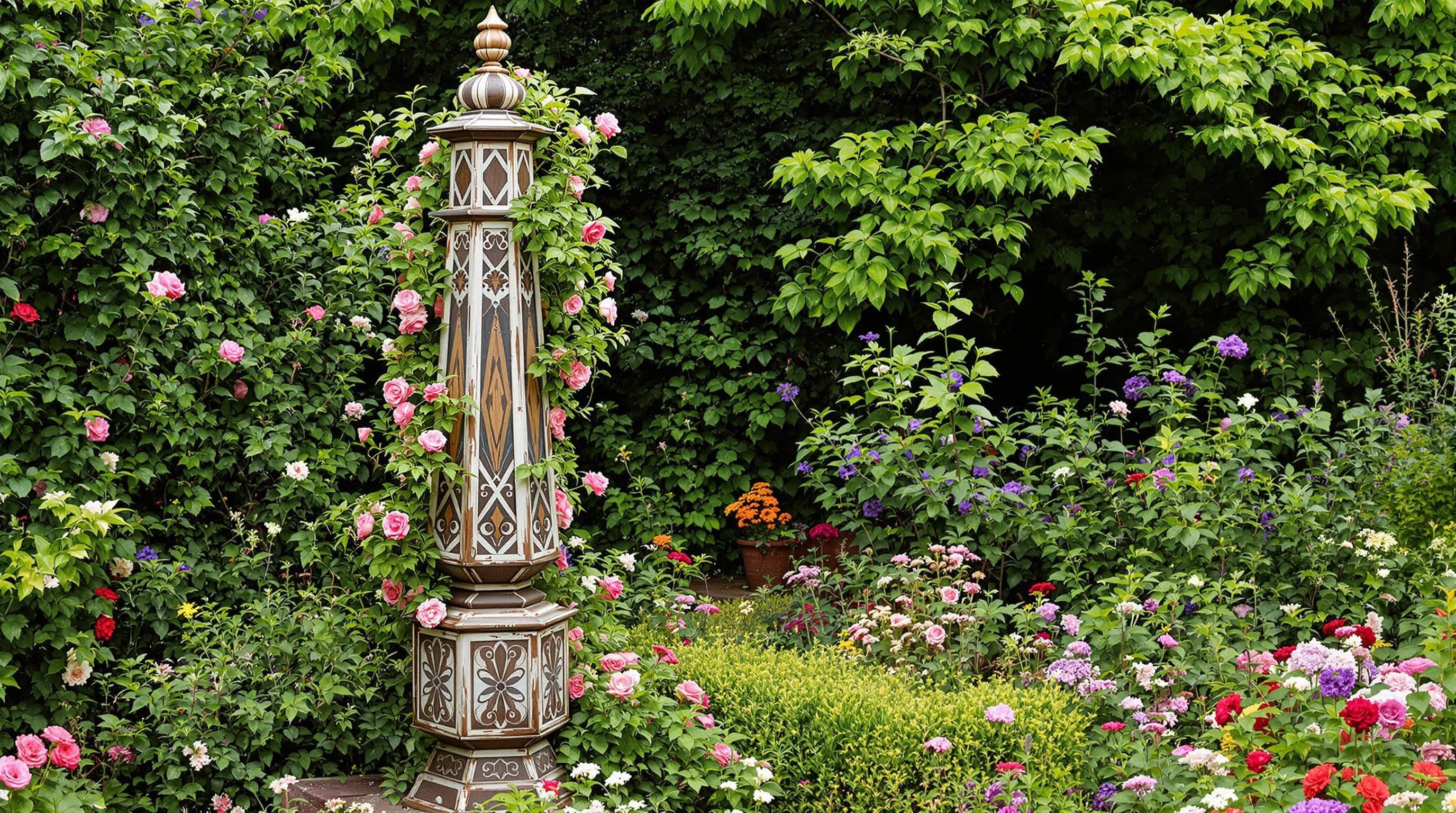
Creating garden obelisks from repurposed materials not only adds unique character to your outdoor space but also contributes to sustainable gardening practices. These eco-friendly structures reduce waste while providing beautiful support for climbing plants.
Using Old Furniture Parts for Unique Designs
Transform discarded furniture into striking garden obelisks that tell a story in your industry. Chair backs with decorative spindles make perfect obelisk sides when arranged in a pyramid formation and secured at the top. Old bed posts can be cut to different lengths and assembled into elegant structures that provide both height and visual interest. Consider repurposing wooden drawer pulls as decorative finials or using table legs as corner posts for your obelisk. Headboards with intricate designs can be cut into sections and reassembled into garden art that supports climbing roses or clematis. The weathered patina of old wooden furniture adds instant character that new materials simply can’t match, creating a vintage aesthetic that improves with age.
Upcycled Wire and Metal Creations
Old metal objects offer unlimited possibilities for creating distinctive garden obelisks with industrial charm. Bicycle wheels stacked vertically and connected with rods create circular climbing supports with interesting geometric patterns. Repurpose metal bed springs into spiral obelisks that provide excellent climbing surfaces for vines like morning glories or pole beans. Old metal fencing can be cut and formed into pyramid shapes, while discarded metal garden tools can be welded together into whimsical structures that celebrate your gardening passion. Even humble wire coat hangers can be untwisted, shaped, and combined to create lightweight trellises perfect for annual climbers. These metal upcycled creations develop beautiful rust patinas over time, blending naturally with your garden’s organic elements while giving new life to items that would otherwise end up in landfills.
Illuminated Garden Obelisks for Nighttime Appeal
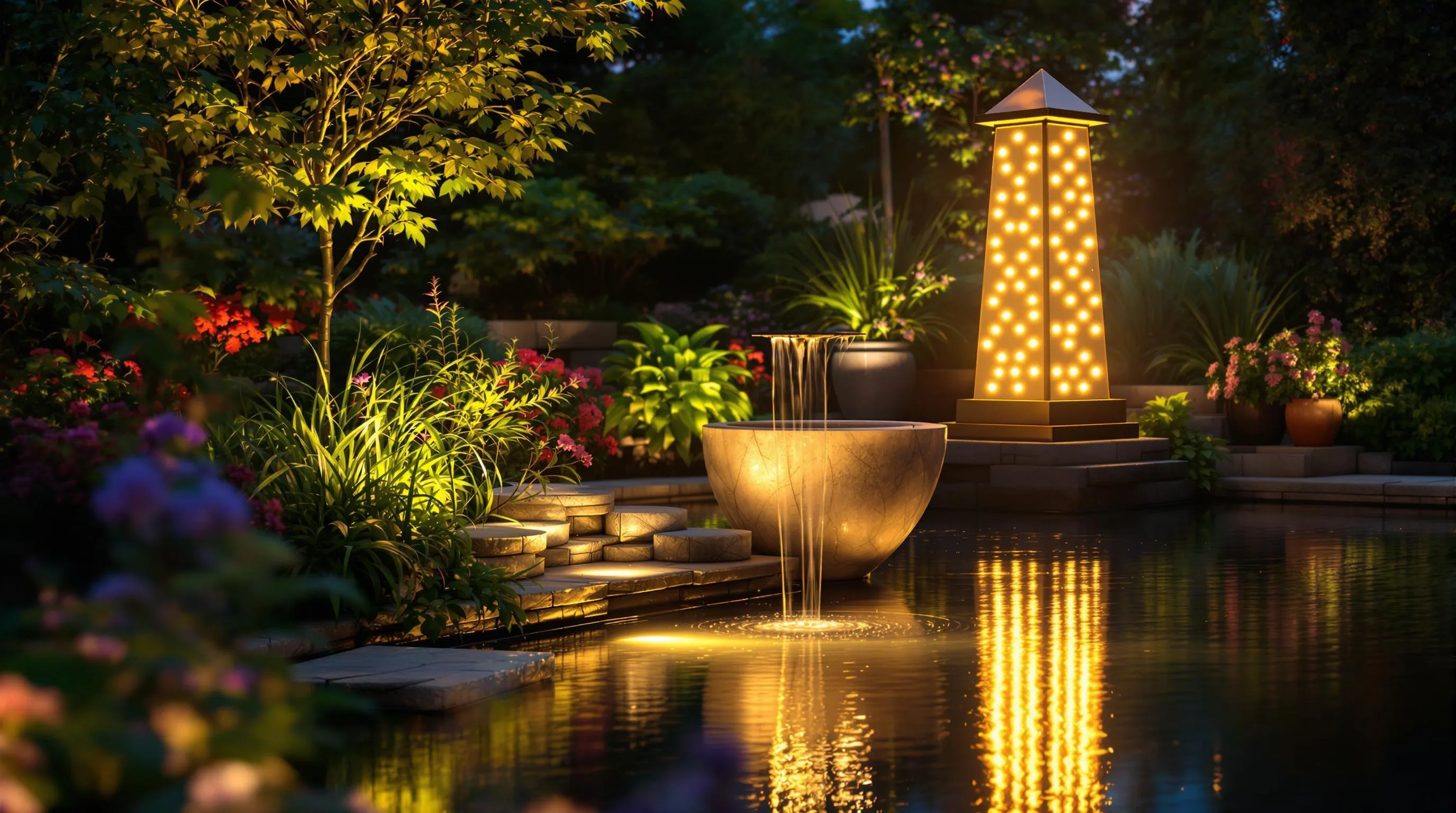
Transform your garden into an enchanting nighttime retreat with illuminated garden obelisks that shine when the sun goes down. These functional art pieces extend your garden’s enjoyment into the evening hours while creating magical focal points.
Solar-Powered Lighting Options
Solar-powered obelisks offer hassle-free illumination that’s both eco-friendly and cost-effective. These sustainable garden features charge during daylight hours and automatically illuminate at dusk, requiring no electrical wiring or ongoing energy costs. Look for models with integrated solar panels discreetly positioned at the top of the structure, or choose designs with detachable solar cells that can be placed in optimal sunlight. Most solar obelisks feature warm white LEDs that cast a gentle glow, though some premium options offer color-changing capabilities to match different garden moods or seasons. For maximum impact, select models with weather-resistant construction and high-efficiency panels that provide 6-8 hours of illumination on a full charge.
Creating Magical Evening Garden Spaces
Strategically placing illuminated obelisks creates captivating nighttime garden rooms that extend your outdoor living hours. Position them at pathway entrances to guide visitors through evening garden tours, or use them as centerpieces in seating areas to provide ambient lighting for outdoor gatherings. For dramatic effect, install illuminated obelisks near water features where the light will reflect and multiply its impact. Pair your glowing structures with climbing plants like moonflower or night-blooming jasmine that release their fragrance after dark, captivating multiple senses. Consider clustering obelisks of varying heights to create a lighthouse effect in garden corners, or line them along a fence line to define boundaries with gentle illumination. The soft glow from these vertical elements adds depth and dimension to nighttime gardens, transforming ordinary spaces into magical retreats.
Seasonal Garden Obelisks That Change With Your Garden

Your garden transforms throughout the year, and your obelisks can evolve alongside it. Seasonal garden obelisks offer versatility that adapts to your garden’s changing needs and appearance through different times of the year.
Winter Structure Ideas
Winter gardens often lack visual interest when plants go dormant, making ornamental obelisks crucial focal points during colder months. Consider evergreen-wrapped obelisks where you weave pine boughs around the structure for a festive touch that persists through winter. Metal obelisks with frost-resistant finishes develop beautiful frost patterns that glisten in winter sunlight. Try adding weather-resistant ornaments like glass balls or metallic decorations to your obelisk frame for holiday sparkle. Painted bright red or deep green obelisks create striking contrast against snow, while those with built-in bird feeders attract wildlife to your winter industry. Position these structures where they’ll catch low winter sun and cast interesting shadows across snow-covered gardens.
Summer Flowering Support Systems
Summer transforms your garden obelisks into living sculptures bursting with color and fragrance. Create clematis towers by positioning these vigorous climbers on sturdy obelisks where they’ll produce waves of blooms from late spring through summer. Morning glory obelisks offer rapid coverage with trumpet-shaped flowers that open fresh each morning. Plant sweet pea pyramids for their intoxicating fragrance and delicate blooms that thrive with vertical support. Climbing rose obelisks become magnificent floral displays when you train thornless climbing varieties up the structure. For edible gardens, bean tepees serve dual purposes as decorative elements and productive growing spaces. Position summer obelisks where they’ll receive 6-8 hours of sun while creating pockets of afternoon shade for heat-sensitive plants beneath them.
Mini Obelisks for Container Gardens and Small Spaces
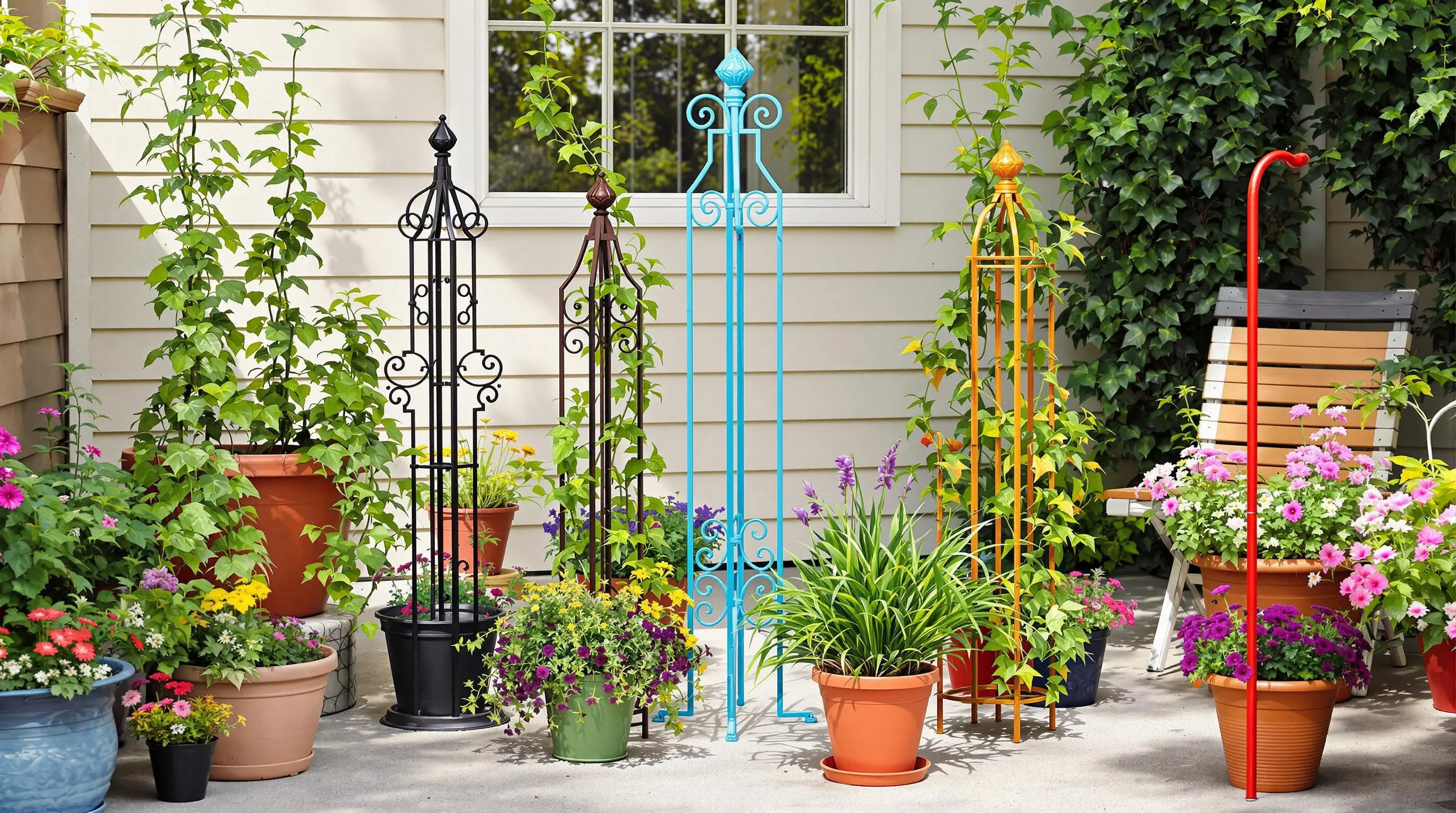
Limited outdoor space doesn’t mean you have to sacrifice style or the joy of growing climbing plants. Mini obelisks offer the perfect solution for small gardens, patios, and even windowsills, bringing vertical interest to compact areas without overwhelming them.
Balcony and Patio Obelisk Designs
Balconies and patios benefit immensely from specially designed mini obelisks that maximize limited square footage. Tabletop copper obelisks standing 12-18 inches tall create stunning focal points when placed in decorative pots with trailing plants like ivy or thunbergia. Foldable wrought iron designs offer practical storage answers during winter months while maintaining elegant scrollwork details. For urban settings, consider sleek powder-coated steel mini obelisks in bold colors that complement contemporary outdoor furniture. These compact structures work brilliantly with container-friendly climbing plants such as black-eyed Susan vine, miniature sweet peas, and dwarf morning glories that won’t overwhelm your small space.
Space-Saving Vertical Garden Answers
Mini obelisks transform vertical space into productive growing areas, multiplying your planting capacity without expanding your footprint. Wall-mounted half-obelisks extend just 8-10 inches from surfaces, creating perfect supports for strawberries, herbs, and compact vegetable varieties like cherry tomatoes. Tiered pot systems with integrated mini obelisks allow you to grow multiple plants in the space normally occupied by a single container. For ultimate flexibility, consider modular obelisk systems with adjustable heights (12-36 inches) that can be reconfigured as your plants grow or your design preferences change. These space-efficient structures offer practical growing answers while adding architectural interest to even the smallest outdoor spaces, turning limited square footage into a flourishing vertical garden.
Concrete and Stone Obelisks for Permanent Garden Fixtures
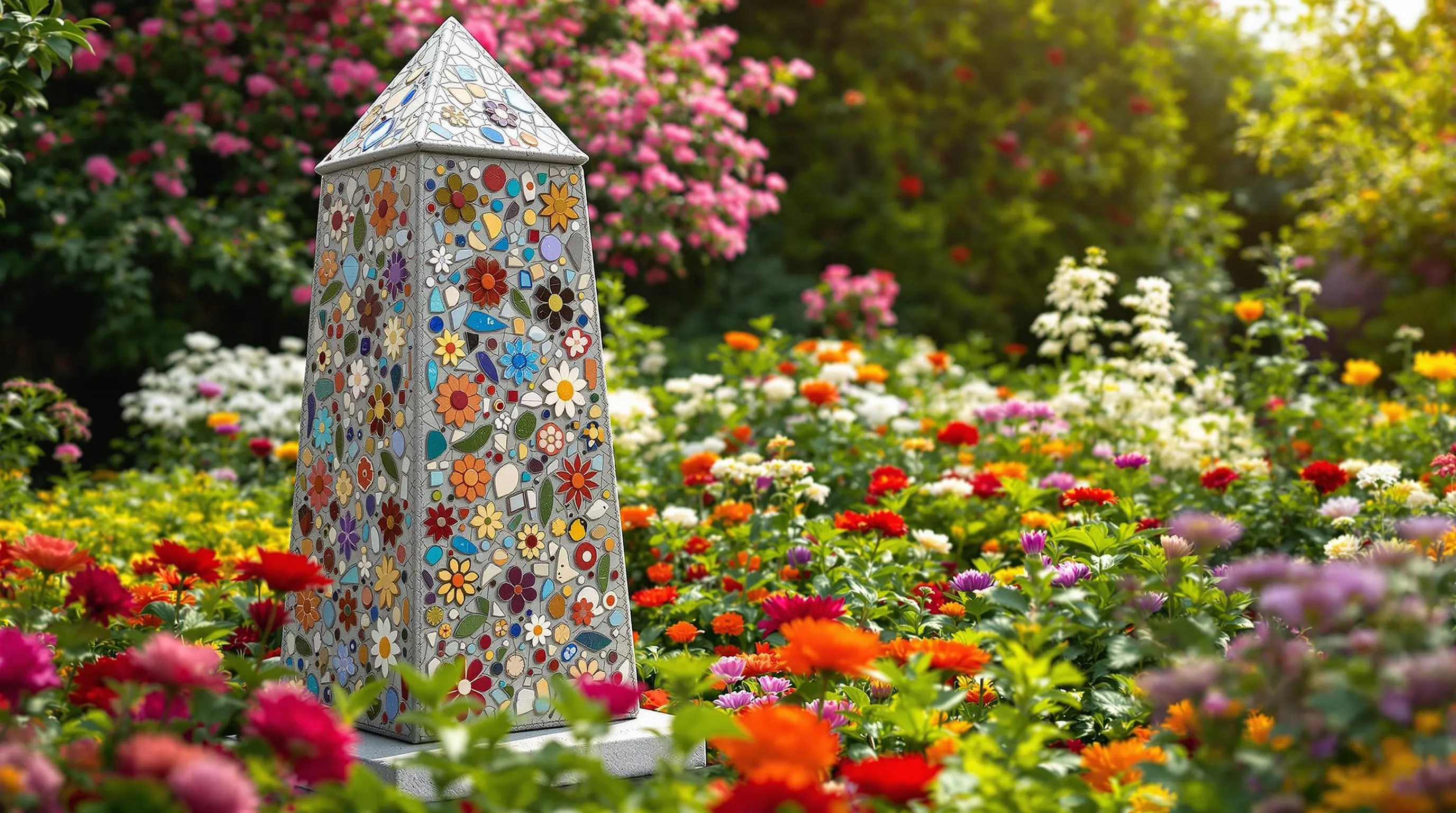
For gardens that demand enduring elegance, concrete and stone obelisks offer unmatched permanence and striking visual appeal. These substantial structures serve as year-round focal points while withstanding harsh weather conditions that might damage more delicate materials.
DIY Concrete Casting Techniques
Creating your own concrete obelisk allows for complete customization while saving money on expensive pre-made options. Start by building a pyramid-shaped mold using melamine boards, which provide smooth surfaces for clean concrete release. Mix your concrete with a water-reducing admixture to improve workability and strength—aim for a consistency similar to thick pancake batter. Pour the mixture carefully into your mold, tapping sides to eliminate air bubbles, and consider embedding rebar for additional structural integrity in taller designs. Allow at least 48 hours of curing time before demolding, then apply a concrete sealer to protect against moisture damage and extend the lifespan of your creation. For added character, experiment with concrete dyes or aggregates like crushed glass or colored stone chips mixed directly into your concrete.
Incorporating Mosaic Elements
Transform ordinary concrete obelisks into stunning art pieces by adding mosaic embellishments that catch light and add personality to your garden. Select weather-resistant materials such as glass tiles, polished stones, or ceramic fragments in colors that complement your garden palette. Create simple geometric patterns for modern gardens or intricate floral designs for traditional spaces. Apply tile adhesive specifically formulated for outdoor use to ensure longevity, and use waterproof grout with added sealer to prevent moisture damage during freeze-thaw cycles. Position your mosaic-adorned obelisk where it receives varying light throughout the day to maximize the play of reflections across its decorated surface. This technique works beautifully on both newly cast concrete pieces and can revitalize older plain obelisks that need refreshing.
Bamboo and Natural Material Obelisks for Sustainable Gardens
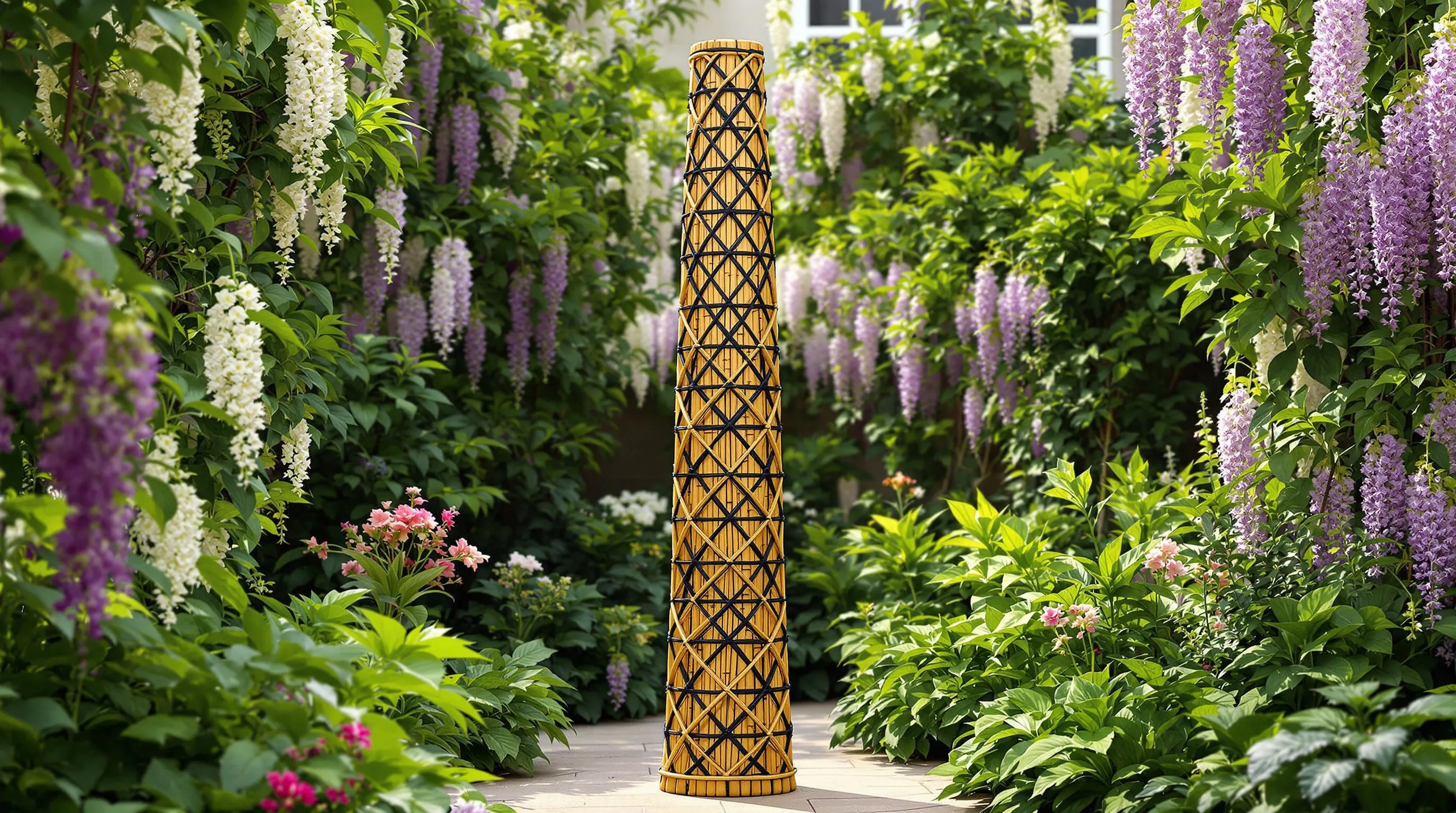
Sustainable gardening meets artistic expression with bamboo and natural material obelisks that add eco-friendly charm to your outdoor space. These environmentally conscious structures not only support climbing plants beautifully but also reduce your garden’s carbon footprint while creating a distinctive aesthetic that connects with nature.
Harvesting and Preparing Materials
Harvesting your own materials for natural obelisks starts with identifying suitable resources in your local environment. Bamboo poles should be cut during the dry season when sap content is lowest, typically in late fall or winter. Select mature bamboo stalks (3-5 years old) with a golden-yellow color and look for straight sections without cracks or insect damage. After harvesting, remove all branches and leaves, then cure the bamboo by standing it upright in a dry, ventilated area for 4-6 weeks. Before construction, treat your bamboo with a natural preservative solution of borax and boric acid (1:1 ratio) to prevent insect infestation and decay. Other excellent natural materials include willow branches, hazel rods, and driftwood—each requiring exact preparation techniques to ensure durability in outdoor conditions.
Asian-Inspired Garden Obelisk Designs
Asian garden aesthetics perfectly complement bamboo obelisks with their emphasis on simplicity, natural materials, and harmonious proportions. Create a Japanese-inspired obelisk by binding bamboo poles with black jute or hemp cord using traditional lashing techniques like square lashing or diagonal lashing. For a Chinese-inspired design, incorporate a pagoda-style tiered top using progressively smaller bamboo sections. Thai-inspired obelisks often feature graceful curves achieved by carefully bending green bamboo with heat treatment. Enhance these designs with decorative elements like hand-carved patterns, red silk tassels, or small wind chimes for gentle garden music. These structures pair beautifully with Asian garden plants such as jasmine, wisteria, or climbing miniature roses to create a tranquil Eastern atmosphere in your sustainable garden space.
Incorporating Garden Obelisks Into Your Landscape Design
Garden obelisks offer endless possibilities to transform your outdoor space with both beauty and function. Whether you choose wrought iron for timeless elegance, illuminated designs for nighttime magic, or sustainable materials for eco-friendly charm, there’s an obelisk perfect for your garden.
Don’t let space constraints limit your creativity – mini obelisks bring vertical interest to containers and small areas. For a personal touch, try DIY projects using wood, concrete, or natural materials to create a truly unique garden feature.
Remember that obelisks provide year-round structure and visual appeal, from supporting vibrant summer climbers to standing as sculptural elements in winter landscapes. By thoughtfully incorporating these versatile structures, you’ll elevate your garden design while providing perfect support for your favorite climbing plants.

